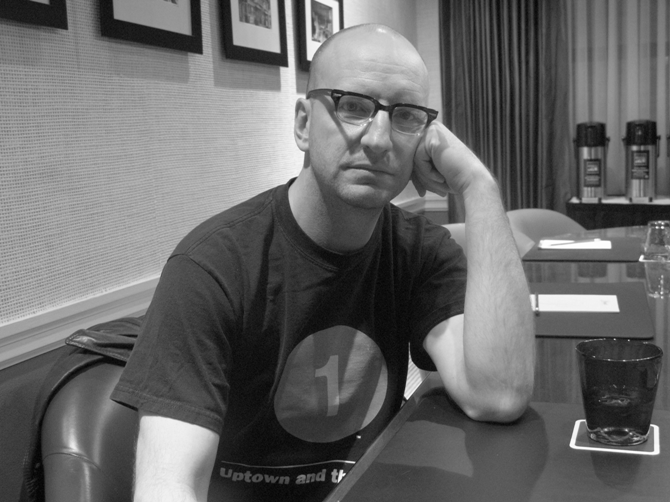
(Photo by Omar P.L. Moore/PopcornReel.com)
Steven Soderbergh, Interpreting Che Guevara Via Unromantic Lenses
By Omar P.L. Moore/The Popcorn Reel
January 25, 2009
SAN FRANCISCO, California -- SHARE
Actions speak louder than words and Steven Soderbergh, the Oscar-winning director of "Traffic", firmly believes in the axiom. "So in my life I look around. I watch. I tend to watch what people do more than what they say. Because people say a lot of things. People say a lot of things that they don't believe. I don't -- I think it's rare that people lie in their actions, you know what I mean? Like, most people do at the end of the day what they want to do. They make time to do what they want to do -- and they may be saying something completely the opposite." Observations like this guided Mr. Soderbergh during the making of his two films "The Argentine" and "Guerrilla", now known as "Che Part One" and "Che Part Two". The films originally debuted in New York and Los Angeles last month as one combined four-hour-and 17-minute epic. Both are currently in theatrical release in North America as separate-admission double-bill presentations. Just before heading off to Park City, Utah for the Sundance Film Festival recently, the Atlanta-born filmmaker stopped by to talk about his seven year-labor, based on the memoirs by Ernesto "Che" Guevara, the Argentina-born medical doctor who decided to leave everything he knew and venture to Cuba to lead that nation in a successful revolution against the oppressive regime of Fulgencio Batista in the late 1950's.
"Che Part One"
Part One, shot in Puerto Rico and Mexico, is based on Mr. Guevara's Reminisces Of The Cuban Revolutionary War and written by Peter Buchman. In it, Benicio Del Toro, who won the Best Actor award for his work in "Che" at last year's Cannes Film Festival, paints an indelible portrait of a man who develops strong leadership qualities and fierce discipline demonstrating his abiding commitment to freedom and justice for Cuba. The film tracks his kinship with then-rebel leader Fidel Castro and highlights as its centerpiece the July-August 1958 Battle of Las Mercedes, the conflict that was a major factor in wresting control of Cuba from its U.S.-sponsored Batista dictatorship. The scenes rendered during this sequence are especially arresting and Mr. Del Toro is strongest in these moments as he exhibits Mr. Guevara's tactical awareness, brilliance and imposition on Cuban forces. Mr. Del Toro wraps the beloved Mr. Guevara in a realm of complete certitude and an uncompromising fervor that is admirable regardless of how one perceives the revolutionary figure. The global prominence of Che Guevara is highlighted in several glimpses of his speech in December 1964 before the United Nations in New York City, which Mr. Soderbergh shot in black and white. Mr. Del Toro won an Academy Award for his supporting performance in Mr. Soderbergh's "Traffic".
The 46-year-old "Full Frontal" filmmaker, who had his birthday the day before this conversation took place, continuously shifted positions in his seat either because the seat was uncomfortable or because he was contemplating, analyzing and reflecting on "Che" and the questions about it -- was very clear about his approach to depicting Mr. Guevara as a "doing" man, electing not to make his subject a reverential, touchy-feely portrait. "It's never gonna be complete," said Mr. Soderbergh, referring to what he termed "creating a mosaic from tiles" of action from Mr. Guevara. Action, after all, as screenplay writers teach, is character. The director has had a diverse array of reactions to the film, ranging from praise to outrage. During a December 2008 screening of "Che" at the Ziegfeld Theater in New York City some audience members engaged in impromptu shouts of "Viva Cuba!" when the image of a map of the country opened Part One. At the same time however, there were the sometimes negative or lukewarm responses, which did not seem to bother him very much at all. "Listen, it's fine when people say, 'the movie's really cold.' And all I can say is, you know, I had people I interviewed that talked to [Che Guevara], all this stuff I read -- that is the impression I got. Even from people who clearly loved him, one of them said to me, 'you had to love him for free.' And I thought that was a really telling -- you could tell this guy (the one whom the director spoke to) felt that there was nobody else like him, that he felt privileged to have spent time with [Che] and fought alongside of him. And at the same time you could tell that this guy would never make the mistake of saying that Che was a friend of his or that he was close to Che or whatever, because you could tell in the way he spoke that Che wasn't close to anyone."
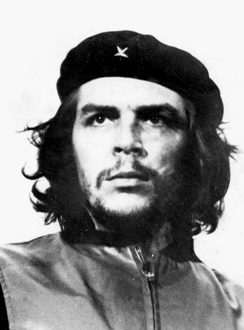
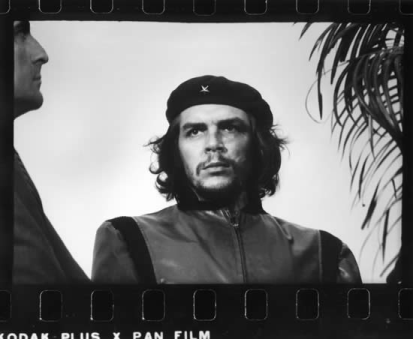
Anatomy of a photograph: Alberto Korda's March 1960 Guerrillero Heroico photograph of Ernesto "Che" Guevara. On the left is the world famous image; on the right is the complete original photo from which the image on the left was excised. (Photos: Alberto Korda)
Anatomy of a photograph
Steven Soderbergh is a thoughtful conversationalist. Not one to engage in pretention or hyperbole, he is measured and sincere in his every word. Even at the end of a day -- a day's worth of interviews -- he is still wired in conversation, something that clearly stimulates him. We discuss Alberto Korda's Guerrillero Heroico photograph of Che Guevara in 1960, recognized at one time as the twentieth century's most famous, recognizable and enduring images worldwide and how the construction of that photograph was more than just a moment and image frozen in time. "You could tell that Che knew that too because there's a -- his expression through the sequence of frames changes a little bit. And I was looking at it going, 'he absolutely knew that he was . . . that he was getting his picture taken and that there was something strong going on.' Maybe I'm projecting, but he was not an idiot -- Che. All of those guys that went through the Cuban Revolution, they were really hyperaware of the role of image in a campaign like that. Most of them were really photogenic . . . a lot of those guys, Camilo Cienfuegos and those guys, are like rock stars -- I mean, they were cool," commented Mr. Soderbergh, who mentions the sad anecdote that Mr. Korda's estate and the Cuban government "is only in the last couple of years trying to sort of wrap their arms around the usage of this photograph for the first time." The director also notes the irony of the image of a virulent anti-capitalist becoming a global capitalistic money maker of millions and millions of dollars, thanks largely to armadas of teenagers over generations, many of whom have no doubt rushed to the multiplex to see any of Mr. Soderbergh's "Ocean's" films starring George Clooney and the cast of a thousand other stars while presumably hesitating to dash with the same speed to see the same director's latest film.
"Che Part Two"
Speaking of which, "Che" Part Two is based on Mr. Guevara's The Bolivia Diary, tracking the revolutionary's post-self-imposed exile from the world of politics with a return, this time to Bolivia where Mr. Guevara, no less respected after the Cuban Revolution triumph, snuck into the South American nation with the intent of helping foment the same successful revolution there. Any student of history knows that Mr. Guevara would ultimately fail, meeting his death in Bolivia. The pace and style of Part Two, which was shot in Spain prior to Part One and written by Peter Buchman and Benjamin A. Van Der Veen, is far more active and immediate, a propulsion of action and drama featuring a real-life guerrilla hero, whom in this section of the epic film Mr. Del Toro thoroughly owns and inhabits. About an hour of the film seems laden with action, with imagery of battle and landscape in harmony via the director's own cinematography, whose pseudonym as the film's director of photography is Peter Andrews, named after his father. The filmmaker, whose career has been one of helming independent film projects with typically small budgets and swift shooting schedules while also crafting blockbuster fare like the "Ocean's" series for the Hollywood studio system, talked about the contrast of experience that Mr. Del Toro had when leaving the set of "Che" to work on the Universal Pictures film "The Wolfman", in which he stars in the title role on the big screen this summer. Apparently the Puerto Rican-born actor was fed up and frustrated with the fact that some of the cast members on "Che" were not on their game right away, according to the "Out Of Sight" director.
The transition from playing a real-life iconic figure in world history to being a werewolf borne from the annals of Marvel Comics wasn't so easy either. On that set, "[Benicio] said he really went bonkers. Because, he goes, 'it would take us all day to shoot me walking down a hall,'" Mr. Soderbergh recalls the actor telling him. Referring to "Che", the filmmaker said that Mr. Del Toro told him that "'we would have shot two battle sequences by now.'"
Such is the agony of an actor sometimes on a Hollywood film set. Hurry up and wait.
A Three-Take Guy
But not so with Mr. Soderbergh, who in all of the films he has directed can think of no instances where he did more than three takes of any given scene, including "Erin Brockovich".
"I'm a three-take guy. If I'm going more than three takes it's because there's either a technical problem, there's a physical, like there's a focus problem where the camera wasn't there or the squib didn't go off or whatever. Or, somebody doesn't know their lines or that there's a problem with the performance. Like, I feel like if I know what's going on and they know what's going on -- if we don't have this done in three takes then there's a problem that needs to be sorted out."
"I guarantee you there isn't a single shot of Julia Roberts in "Erin Brockovich" that took more than three takes. I can prove it," said Mr. Soderbergh, who in 2001 was one of the first, if not the only director ever to be nominated for a Best Director Academy Award for two films ("Erin Brockovich" and "Traffic") in the same year, winning for "Traffic".
"In four and a half hours I'd say there's four or five takes of Benicio that aren't take one, two or three. And a lot of them are take one or two. Cause we had to move so fast," said the director, whose economy of direction is well-documented by a resume of films that includes "Bubble", a film with an entire cast of non-professional actors which was done very quickly and was released theatrically, on DVD and on cable television via the channel HDNet Movies all on the same day.
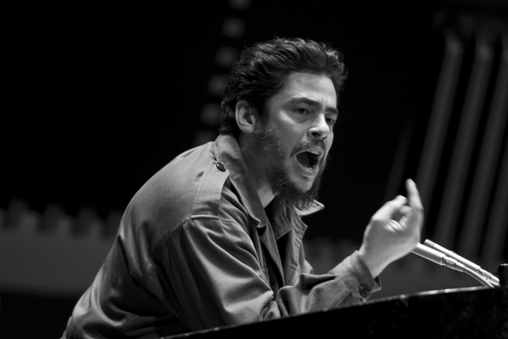
Benicio Del Toro as Che Guevara in a scene during Mr. Guevara's famous 1964 speech at the United Nations, in "Che Part One", directed by Steven Soderbergh. (Photo: IFC Films)
Preparing for "Che"
Prior to shooting his epic film Mr. Soderbergh watched a previous feature film on Che Guevara, also called "Che" but with an exclamation mark at the end of its title. The 1969 film, directed by Richard Fleischer starred Omar Sharif in the title role and Jack Palance as Fidel Castro. "There's some sort of creative conceits in it that are fascinating," the filmmaker observed, adding that "it's also fascinating to think that within a year and a half of [Mr. Guevara's] death that a major film studio -- the film studio that made Doctor Doolittle financed and released this movie all over the country. Like that's kind of strange in and of itself. I thought I was going to be more amused by it than I was," the "Solaris" director conceded. Mr. Soderbergh admitted that "at a certain point [prior to filming] . . . I had to stop watching it because first of all it wasn't making me -- I wasn't laughing at it or with it or anything. I was just starting to get scared because there were just so many scenes that they were doing that we were doing and all I could think was that, 'oh we're just doing the high-brow version of that' and it started to scare me a little bit."
The cure for the scare? "Bananas", Woody Allen's film. Mr. Soderbergh said that he watched the DVD of Mr. Allen's film "to cleanse his palette". When Mr. Allen's name is repeated in disbelief by the interviewer a brief silence passes during which the director is expressionless, an atypical reaction from the highly-engaged Mr. Soderbergh, who married former MTV personality and model Jules Asner in 2004. One wonders whether the idea of watching Mr. Allen's film was a stress reliever given the task ahead of Mr. Soderbergh or whether he was registering a very subtle displeasure at the questioner's incredulity regarding "Bananas". Nevertheless, Mr. Soderbergh again recalled the 1969 film "Che!".
"When we were done and I finally watched the whole thing, it's the Jack Palance part of it that's fantastic . . . because he's playing [Castro] as part of a combination of like Groucho Marx and Tony Soprano. And it's just the funniest shit ever. Like your mouth is hanging open."
He cites a scene in a huge luxury suite in which Mr. Palance as Mr. Castro is in bed smoking a big cigar and Mr. Sharif as Che Guevara, enters.
"It's just hilarious. But again, before we started shooting -- not so hilarious."
Mr. Soderbergh said that he and Mr. Del Toro, whom produced "Che" with Laura Bickford, were both "so happy" when they found actor Démian Bechir to play Fidel Castro. "He just kind of came in with confidence -- which is really what it's about. Benicio and I knew that if we didn't have anybody to come in and go toe-to-toe with [him], like, the movie's dead. If you (as an actor) don't understand that Che is initially cowed by Fidel then the story doesn't make sense . . . Démian just came in and was just like -- 'I can do this.'"
"The Battle Of Algiers"
When watching some moments of Mr. Soderbergh's "Che Part Two" one can't help thinking about "The Battle Of Algiers", a film which the director hailed as as "masterpiece".
"I mean it's literally in my book, literally one of the best things anybody's ever made. Extraordinary for its extreme verisimilitude. I mean, to the point where them having to put that card in the front of the film saying, 'not a foot of this film is documentary footage.'" The conversation about "Algiers" spurs the director to talk about the political nature of the circumstances of that film and the climate in which it was released in the mid-1960's, less than ten years after Algeria won its revolution and gained its independence from France, its former colonizer. "I mean, the movie was banned in France for decades. It couldn't even be screened."
"That's a movie that my whole life I've considered a sort of Rosetta stone -- particularly when we were making "Traffic" I was watching that a lot. Just because the way that . . . the camera becomes a participant in what's going on. The intimacy of it is so intense and that is what we were trying to create (on "Traffic".) The director referred back to "Che Part Two", citing the visceral cinematic qualities of "Algiers" that he employed in it.
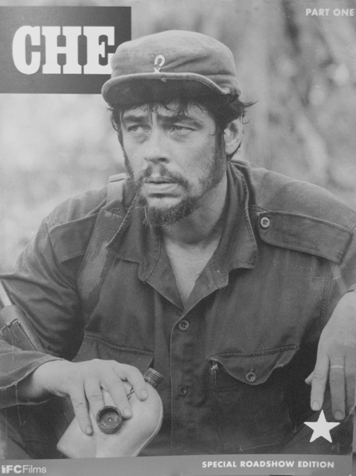
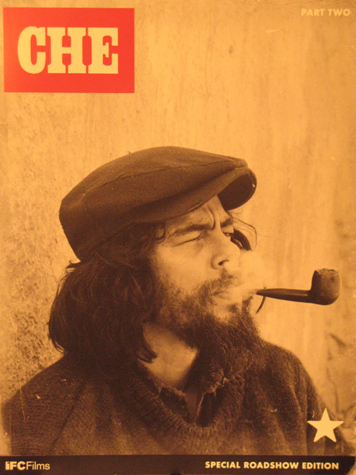
Benicio Del Toro as Ernesto "Che" Guevara, pictured in a special booklet from Steven Soderbergh's films "Che Part One" and "Che Part Two", which expanded their release across much of the U.S. and Canada on January 16 and January 23.
Moving Between Movie Worlds
Some have called Steven Soderbergh a multitasker in the film world chiefly due to his ability to effortlessly shift between both the mainstream and independent genres. Filmmaking is filmmaking, no matter what. "It's really the same," he says. Still, distinctions can readily be made. "They're different in a sense that I'm very aware of the fact that if I'm spending a hundred million dollars that there are certain things that I can do creatively and they're certain things I can't do creatively that just go along with making an Ocean's movie. And that's fine because I love caper films, so, you know, it's not a problem. And surprisingly for me I think there's a lot of play in there to be had if you're interested in playing. And one of the reasons those films are fun for me is visually I get to do things that I can't get to justify in any other movie. I can really play in a way that it wouldn't be appropriate in other kinds of films -- on a drama or you know, on a more serious movie. But the process is kind of the same. You're still sitting there trying to figure out how to make something work."
The hard-working director's forthcoming film "The Informant", starring Matt Damon and based on the true story of Archer Daniels whistleblower Mark Whitacre, is scheduled to be released in the U.S. and Canada on September 18 from Warner Brothers. His other new film, the low-budget "The Girlfriend Experience" (about prostitution as seen through the eyes of a high-priced call girl) was first shown in the U.S. at this year's Sundance Film Festival in sneak peek fashion for audiences. The film was shot in New York City last year and stars Sacramento-born photographer, stage, film and pornography actress Sasha Grey, the Adult Video Network Female Performer of the Year for 2008. "The Girlfriend Experience" is scheduled for release in North America via Magnolia Pictures sometime this year.
Mr. Soderbergh was under no illusion about who his films are for. "People say, 'this one's for them and this one's' -- no. They're all for me. They're all for me. This is my life. This is my life. I spent years on these things. I'm not giving away two years for somebody else so that I can have three months for myself. I don't do that. I think it's -- it just must be hard for -- I don't understand why it's so hard for some people to understand that I get pleasure out of both. Don't they see both movies? Don't they like to see both? I don't get it."
Sex, Lies And Sundance -- 20 Years Later
Before heading to Sundance to talk about his 1989 debut feature film "sex, lies and videotape", Mr. Soderbergh was asked about the film, which also debuted at the Sundance Film Festival 20 years ago and shows there again this year. The Cannes Film Festival Palm D'Or-winning-film starred James Spader. Mr. Soderbergh revealed that he hadn't seen the film since it was re-mastered for DVD in 1997. "Yeah, that'll be weird."
"What's funny (since 1989) is not only has the business changed but to think about the subject of the film even, and the fact that it exists pre-Internet and that Spader's proclivities in this movie look positively Victorian next to what you can get in two clicks you know, at Porn Hub. Like, I don't even know how that's gonna come across. He's gonna look like Miss Haversham or something. It's gonna look quaint, I think. They're (Andie MacDowell and Mr. Spader) just talking? There can't be any part of it that's shocking now, I think. Not that it was built on being shocking, but that's gonna be weird. I mean that whole -- I was just saying that aspect of that culture has changed completely, just completely."
"Che Part One" and "Che Part Two" are now playing across North America in select cities as separate admission double-bill presentations. The films will open next month in the United Kingdom and several other territories and countries around the globe. Separately, each film is roughly two hours and eight minutes long.
PopcornReel.com "Che Part One" and "Che Part Two" film review
The Popcorn Reel Hot Minute YouTube Review: "Che Part One" and "Che Part Two"